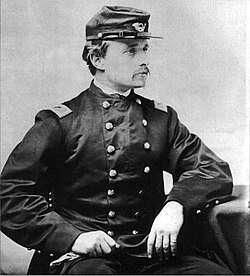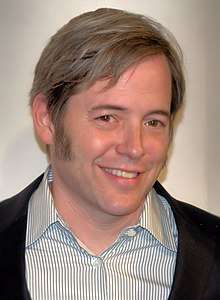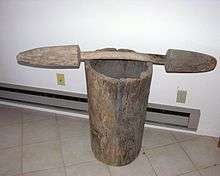Glory (1989 film)
| Glory | |
|---|---|
_poster.jpg) Theatrical release poster | |
| Directed by | Edward Zwick |
| Produced by | Freddie Fields |
| Screenplay by | Kevin Jarre |
| Based on |
Lay This Laurel by Lincoln Kirstein One Gallant Rush by Peter Burchard |
| Starring | |
| Music by | James Horner |
| Cinematography | Freddie Francis |
| Edited by | Steven Rosenblum |
Production company |
Freddie Fields Productions |
| Distributed by | TriStar Pictures |
Release date |
|
Running time | 122 minutes |
| Country | United States |
| Language | English |
| Budget | $18 million[1] |
| Box office | $26.8 million[2] |
Glory is a 1989 American war film directed by Edward Zwick, starring Matthew Broderick, Denzel Washington, Cary Elwes and Morgan Freeman. The screenplay by Kevin Jarre was based on the books Lay This Laurel by Lincoln Kirstein and One Gallant Rush by Peter Burchard, and the personal letters of Colonel Robert Gould Shaw. The end credits are superimposed on photos of the monument to the 54th Massachusetts Volunteer Infantry on Boston Common.
The film is about one of the first military units of the Union Army, during the American Civil War, to consist entirely of African-American men (except for its officers), as told from the point of view of Colonel Shaw, its white commanding officer. The regiment is known especially for its heroic actions at Fort Wagner.
Glory was nominated for five Academy Awards and won three, including one for Denzel Washington for Best Supporting Actor for his portrayal of Private Silas Tripp. It won many other awards from, among others, the British Academy of Film and Television Arts, the Golden Globe Awards, the Kansas City Film Critics Circle, the Political Film Society, and the NAACP Image Awards.
The film was co-produced by TriStar Pictures and Freddie Fields Productions, and distributed by Tri-Star Pictures in the United States. It premiered in limited release in the US on December 14, 1989, and in wide release on February 16, 1990, making $26,828,365 on an $18 million budget. The soundtrack, composed by James Horner and performed in part by Boys Choir of Harlem, was released on January 23, 1990. The home video was distributed by Sony Pictures Home Entertainment. On June 2, 2009, a widescreen Blu-ray version, featuring the director's commentary and deleted scenes, was released.
Plot
During the American Civil War, Captain Robert Shaw, injured at Antietam, is sent home to Boston on medical leave. Shaw accepts a promotion to colonel commanding the 54th Regiment Massachusetts Volunteer Infantry, one of the first all-black regiments in the Union Army. He asks his friend, Cabot Forbes, to serve as his second in command, with the rank of major. Their first volunteer is another friend, Thomas Searles, a bookish, free African-American. Other recruits include John Rawlins, Jupiter Sharts, Silas Tripp, and a mute teenage drummer boy.
The men learn that, in response to the Emancipation Proclamation, the Confederacy has issued an order that all black soldiers will be returned to slavery. Black soldiers found in a Union uniform will be executed as well as their white officers. They are offered, but turn down, a chance to take an honorable discharge. They undergo rigorous training with Sergeant-Major Mulcahy, which Shaw realizes is to prepare them for the challenges they will face.
Tripp goes AWOL and is caught; Shaw orders him flogged in front of the troops. He then learns that Tripp left to find shoes to replace his worn ones because his men are being denied supplies. He confronts the base's racist quartermaster on their behalf. Shaw also supports them in a pay dispute, as the Federal government pays black soldiers $10, not the $13 per month white soldiers earn. When the men begin tearing up their pay stubs in protest of the unequal treatment, Shaw tears up his own pay stub in support of their actions. In recognition of his leadership, Shaw promotes Rawlins to the rank of Sergeant-Major.
Once the 54th completes its training, they are transferred under the command of General Charles Harker. On the way to South Carolina they are ordered by Colonel James Montgomery to sack and burn Darien, Georgia. Shaw initially refuses to obey an unlawful order, but agrees under threat of having his troops taken away. He continues to lobby his superiors to allow his men to join the fight, as their duties to date have involved mostly manual labor, for which they are mocked. Shaw finally gets the 54th into combat after he confronts Harker and threatens to report the illegal activities he has discovered. In their first battle at James Island, South Carolina, the 54th successfully defeats a Confederate attack that had routed other units. During the battle, Searles is wounded but saves Tripp. Shaw offers Tripp the honor of bearing the regimental flag in battle. He declines, not believing the war will result in a better life for slaves.
General George Strong informs Shaw of a major campaign to secure a foothold at Charleston Harbor. This involves assaulting Morris Island and capturing Fort Wagner, whose only landward approach is a strip of open beach; a charge is certain to result in heavy casualties. Shaw volunteers the 54th to lead the attack. The night before the battle, the black soldiers conduct a religious service. Several make emotional speeches to inspire others. On their way to the battlefield, the 54th is cheered by the same Union troops who had scorned them earlier.
The 54th leads the charge on the fort, suffering serious losses. As night falls, the regiment is pinned down against the walls of the fort. Attempting to encourage his men, Shaw is killed. Tripp lifts the flag, rallying the soldiers to continue, but he too is soon shot dead. Forbes takes charge, and the soldiers break through the fort's defenses. On the brink of victory, Forbes, Rawlins, Searles, Sharts, and the two Color Sergeants are fired upon by Confederate artillery. The morning after the battle, the beach is littered with bodies of Union soldiers; the Confederate flag is raised over the fort. The dead Union soldiers are buried in a mass grave, with Shaw and Tripp's bodies next to each other.
Closing text reveals Fort Wagner never fell to the Union Army. However, the courage demonstrated by the 54th resulted in the Union accepting thousands of black men for combat, and President Abraham Lincoln credited them with helping to turn the tide of the war.
Cast
- Matthew Broderick as Colonel Robert Gould Shaw
- Denzel Washington as Private Silas Tripp
- Morgan Freeman as Sergeant Major John Rawlins
- Cary Elwes as Major Cabot Forbes
- Andre Braugher as Corporal Thomas Searles
- Jihmi Kennedy as Private Jupiter Sharts
- Cliff De Young as Colonel James Montgomery
- Alan North as Governor John Albion Andrew
- John Finn as Sergeant Major Mulcahy
- RonReaco Lee as Mute Drummer Boy
- Donovan Leitch as Captain Charles Fessenden Morse
- Bob Gunton as General Charles Garrison Harker
- Jay O. Sanders as General George Crockett Strong
- Raymond St. Jacques as Frederick Douglass
- Richard Riehle as Quartermaster
- JD Cullum as Henry Sturgis Russell
- Christian Baskous as Edward L. Pierce
- Peter Michael Goetz as Francis Shaw
- Jane Alexander as Sarah Blake Sturgis Shaw (uncredited)
Production
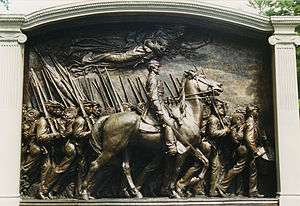
Kevin Jarre's inspiration for writing the film came from viewing the monument to Colonel Shaw and the 54th Massachusetts Volunteer Infantry in Boston Common.[3] The 54th was the first formal unit of the U.S. Army to be made up entirely of African-American enlisted men; all of the officers were white men. His screenplay was based on two books, Lincoln Kirstein's Lay This Laurel (1973) and Peter Burchard's One Gallant Rush (1965), and the personal letters of Robert Gould Shaw.[4]
Exterior filming took place primarily in Massachusetts and Georgia. Opening passages, meant to portray the Battle of Antietam, show volunteer military reenactors filmed at a major engagement at the Gettysburg battlefield. Zwick did not want to turn Glory "into a black story with a more commercially convenient white hero".[5] Actor Morgan Freeman noted: "We didn't want this film to fall under that shadow. This is a picture about the 54th Regiment, not Colonel Shaw, but at the same time the two are inseparable."[5] Zwick hired the writer Shelby Foote as a technical adviser; he later became widely known for his contributions to Ken Burns' popular PBS nine-episode documentary, The Civil War (1990).[5]
The film contains numerous inaccuracies. The movie implies that most of the soldiers in the regiment were former slaves, when in fact a majority had been born free in the North. The regiment was not formed until early 1863, so they were not in camp for Christmas of 1862, and on the day the recruits arrived at Readville, they were given uniforms and new boots so soldiers were not reduced to marching barefoot in cold mud, as the film depicts. While the film shows Shaw volunteering his unit immediately after hearing General Strong describe Fort Wagner's defenses, the regimental commanders had conferred among themselves before going back to Strong and telling him that the 54th was to make the charge. Another inaccuracy is in showing the 54th attacking the fort from north to south with the ocean on their left. The actual attack occurred from the opposite direction, with the ocean on the right parallel to the regiment. Despite the film's closing statement that Wagner was never taken by U.S. forces, it fell to Union hands in September 1863 after further shelling from the U.S. Navy.
Glory was the first major motion picture to tell the story of black U.S. soldiers fighting for their freedom from slavery during the Civil War. The 1965 James Stewart film Shenandoah also depicted black soldiers fighting for the Union, but the script suggested the Union army at that time was integrated.
Soundtrack
| Glory: Original Motion Picture Soundtrack | |
|---|---|
| Film score by James Horner | |
| Released | November 1, 1990 |
| Length | 43:21 |
| Label | Virgin |
Glory's original motion picture soundtrack was released by Virgin Records on January 11, 1990. The score for the film was orchestrated by James Horner in association with the Boys Choir of Harlem.[6] Jim Henrikson edited the film's music, while Shawn Murphy mixed the score.[7]
Marketing
Monograph
A nonfiction study of the regiment first appeared in 1965 and was republished in paperback in January 1990 by St. Martin's Press under the title One Gallant Rush: Robert Gould Shaw and His Brave Black Regiment. The book expands on how the 54th Massachusetts developed as battle-ready soldiers.[8] Summarizing the historical events, the book provides events surrounding the aftermath of the first Black Union regiment and how it influenced the outcome of the war.[8]
Reception
Critical response
Film critic Vincent Canby's review in The New York Times stated, "[Broderick] gives his most mature and controlled performance to date....[Washington is] an actor clearly on his way to a major screen career...The movie unfolds in a succession of often brilliantly realized vignettes tracing the 54th's organization, training and first experiences below the Mason-Dixon line. The characters' idiosyncrasies emerge."[4] Roger Ebert in the Chicago Sun-Times called it "a strong and valuable film no matter whose eyes it is seen through".[3] He believed the production design credited to Norman Garwood and the cinematography of Freddie Francis paid "enormous attention to period detail".[3]
| Watching "Glory," I had one reccuring [sic] problem. I didn't understand why it had to be told so often from the point of view of the 54th's white commanding officer. Why did we see the black troops through his eyes — instead of seeing him through theirs? To put it another way, why does the top billing in this movie go to a white actor? |
| —Roger Ebert, writing in the Chicago Sun-Times[3] |
The film was not without its detractors. Peter Travers of Rolling Stone was not impressed at all with the overall acting, calling Broderick "catastrophically miscast as Shaw".[9] Alternatively, Richard Schickel of Time described the picture by saying, "the movie's often awesome imagery and a bravely soaring choral score by James Horner that transfigure the reality, granting it the status of necessary myth".[10] Desson Howe of The Washington Post, pointed out some flaws that included mentioning Broderick as "an amiable non-presence, creating unintentionally the notion that the 54th earned their stripes despite wimpy leadership".[11]
James Berardinelli writing for ReelViews, called the film "without question, one of the best movies ever made about the American Civil War," and noted that it "has important things to say, yet it does so without becoming pedantic".[12] Rating the film with four stars, critic Leonard Maltin wrote that it was "grand, moving, breathtakingly filmed (by veteran cinematographer Freddie Francis) and faultlessly performed" and called it "one of the finest historical dramas ever made".[13]
Gene Siskel of the Chicago Tribune gave the film a thumbs up review, saying, "like Driving Miss Daisy, this is another admirable film that turns out to be surprisingly entertaining". He thought the film took on "some true social significance" and felt the actors portrayed the characters as "more than simply black men". He explained: "They're so different, that they become not merely standard Hollywood blacks, but true individuals."[14]
American Civil War historian James M. McPherson stated the film "accomplished a remarkable feat in sensitizing a lot of today's black students to the role that their ancestors played in the Civil War in winning their own freedom".[15]
On Rotten Tomatoes, the film holds an approval rating of 93% based on 41 reviews, and an average rating of 7.9/10.[16]
Accolades
The film was nominated and won several awards in 1989–90.[17][18] A complete list of awards the film won or was nominated for are listed below.
| Award | Category | Nominee | Result |
|---|---|---|---|
| 62nd Academy Awards[19] | Best Actor in a Supporting Role | Denzel Washington | Won |
| Best Art Direction | Norman Garwood, Garrett Lewis | Nominated | |
| Best Cinematography | Freddie Francis | Won | |
| Best Film Editing | Steven Rosenblum | Nominated | |
| Best Sound | Donald O. Mitchell, Gregg Rudloff, Elliot Tyson, Russell Williams II | Won | |
| 41st ACE Eddie Awards[20] | Best Edited Feature Film | ———— | Won |
| 44th British Academy Film Awards[21] | Best Cinematography | Freddie Francis | Nominated |
| British Society of Cinematographers Awards 1990[22] | Best Cinematography | Freddie Francis | Won |
| Casting Society of America Artios Awards 1990[23] | Best Casting for Feature Film, Drama | Mary Colquhoun | Nominated |
| 47th Golden Globe Awards[24] | Best Motion Picture – Drama | Freddie Fields | Nominated |
| Best Supporting Actor – Motion Picture | Denzel Washington | Won | |
| Best Director | Edward Zwick | Nominated | |
| Best Screenplay | Kevin Jarre | Nominated | |
| Best Original Score | James Horner | Nominated | |
| 33rd Grammy Awards[25] | Best Instrumental Composition Written for a Motion Picture or for Television | James Horner | Won |
| Kansas City Film Critics Circle Awards 1989[26] | Best Film | ———— | Won |
| Best Director | Edward Zwick | Won | |
| Best Supporting Actor | Denzel Washington | Won | |
| NAACP Image Awards 1992[27][28] | Outstanding Motion Picture | ———— | Won |
| Outstanding Supporting Actor in a Motion Picture | Denzel Washington | Won | |
| 1989 National Board of Review of Motion Pictures Awards[29] | Best Picture | ———— | Nominated |
| 1989 New York Film Critics Circle Awards[30] | Best Supporting Actor | Denzel Washington | Nominated |
| 1990 Political Film Society Awards[31] | Human Rights | ———— | Nominated |
| Writers Guild of America Awards 1989[32] | Best Adapted Screenplay | Kevin Jarre | Nominated |
American Film Institute Lists
- AFI's 100 Years...100 Movies - Nominated
- AFI's 100 Years...100 Thrills - Nominated
- AFI's 100 Years...100 Heroes and Villains:
- Trip - Nominated Hero
- AFI's 100 Years of Film Scores - Nominated
- AFI's 100 Years...100 Cheers - #31
- AFI's 100 Years...100 Movies (10th Anniversary Edition) - Nominated
Box office
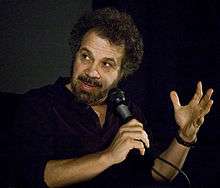
The film premiered in cinemas on December 14, 1989, in limited release within the US. During its limited opening weekend, the film grossed $63,661 in business showing at 3 locations. Its official wide release began in theaters on February 16, 1990.[2] Opening in a distant 8th place, the film earned $2,683,350 showing at 801 cinemas. The film Driving Miss Daisy soundly beat its competition during that weekend opening in first place with $9,834,744.[33] The film's revenue dropped by 37% in its second week of release, earning $1,682,720. For that particular weekend, the film remained in 8th place screening in 809 theaters not challenging a top five position. The film Driving Miss Daisy, remained in first place grossing $6,107,836 in box office revenue.[34] The film went on to top out domestically at $26,828,365 in total ticket sales through a 17-week theatrical run.[2] For 1989 as a whole, the film would cumulatively rank at a box office performance position of 45.[35]
Home media
Following its release in theaters, the film was released on VHS video format on June 22, 1990.[36] The Region 1 DVD widescreen edition of the film was released in the US on January 20, 1998. Special DVD features include: interactive menus, scene selections, widescreen 1.85:1 color anamorphic format, along with subtitles in English, Italian, Spanish and French.[37]
A special repackaged version of Glory was also officially released on DVD on January 2, 2007. It includes two discs featuring: widescreen and full screen versions of the film; Picture-in-Picture video commentary by director Ed Zwick and actors Morgan Freeman and Matthew Broderick; a director's audio commentary; and a documentary entitled, The True Story of Glory Continues narrated by Morgan Freeman. Also included are: an exclusive featurette entitled, Voices of Glory, an original featurette, deleted scenes, production notes, theatrical trailers, talent files, and scene selections.[38]
The Blu-ray disc version of the film was released on June 2, 2009. Special features include: a virtual civil war battlefield, interactive map, The Voice Of Glory feature, The True Story Continues documentary, the making of Glory, director's commentary, and deleted scenes.[39] The film is displayed in widescreen 1.85:1 color format in 1080p screen resolution. The audio is enhanced with Dolby TrueHD sound and is available with subtitles in English, Spanish, French, and Portuguese.[39] A UMD version of the film for the Sony PlayStation Portable was also released on July 1, 2008. It features dubbed, subtitled, and color widescreen format viewing options.[40]
See also
References
- ↑ "Glory". The Numbers. Retrieved November 7, 2010.
- 1 2 3 "Glory". Box Office Mojo. Retrieved November 7, 2010.
- 1 2 3 4 Ebert, Roger (January 12, 1990). Glory.Chicago Sun-Times. Retrieved 2010-11-07.
- 1 2 Canby, Vincent (December 14, 1989). Glory (1989). The New York Times. Retrieved 2010-11-07.
- 1 2 3 "Glory (1989)". Turner Classic Movies. Retrieved November 7, 2010.
- ↑ Glory Original Motion Picture Soundtrack. Barnes & Noble. Retrieved 2010-11-07.
- ↑ "Glory (1989) Cast and Credits". Yahoo! Movies. Retrieved November 7, 2010.
- 1 2 Burchard, Peter (1990). One Gallant Rush: Robert Gould Shaw and His Brave Black Regiment. St. Martin's Press. ISBN 978-0-312-04643-9.
- ↑ Travers, Peter (December 1989). Glory (1989). Rolling Stone. Retrieved 2010-11-07.
- ↑ Schickel, Richard (December 5, 1989). Cinema: Of Time and the River. TIME. Retrieved 2010-11-07.
- ↑ Desson, Howe (January 12, 1990). 'Glory' (R). The Washington Post. Retrieved 2010-11-07.
- ↑ Berardinelli, James (December 1989). Glory. ReelViews. Retrieved 2010-11-07.
- ↑ Maltin, Leonard (August 5, 2008). Leonard Maltin's 2009 Movie Guide. Signet. p. 528. ISBN 978-0-452-28978-9.
- ↑ Siskel, Gene (December 1989). Glory. At the Movies. Retrieved 2010-11-07.
- ↑ McPherson, James M.; Lamb, Brian (May 22, 1994). "James McPherson: What They Fought For, 1861-1865". Booknotes. National Cable Satellite Corporation. Retrieved May 27, 2018.
Glory accomplished a remarkable feat in sensitizing a lot of today's black students to the role that their ancestors played in the Civil War in winning their own freedom.
- ↑ http://www.rottentomatoes.com/m/1008415-glory/
- ↑ "Glory: Awards & Nominations". MSN Movies. Retrieved November 7, 2010.
- ↑ "Glory (1989) Awards & Nominations". Yahoo! Movies. Archived from the original on 2008-02-16. Retrieved November 7, 2010.
- ↑ "Nominees & Winners for the 62nd Academy Awards". Academy of Motion Picture Arts and Sciences. March 26, 1990. Archived from the original on February 21, 2014. Retrieved January 24, 2016.
- ↑ "Nominees & Recipients". American Cinema Editors. Archived from the original on February 24, 2011. Retrieved November 7, 2010.
- ↑ "Film Nominations 1990". British Academy of Film and Television Arts. Archived from the original on December 26, 2007. Retrieved January 24, 2016.
- ↑ "Best Cinematography Award". The British Society of Cinematographers. Archived from the original on 2009-04-14. Retrieved November 7, 2010.
- ↑ "Artios Award Winners". CastingSociety.com. Retrieved November 7, 2010.
- ↑ "Glory". GoldenGlobes.org. Archived from the original on September 29, 2006. Retrieved November 7, 2010.
- ↑ "Videos for 33rd Annual Grammy Awards". Grammy.com. Retrieved November 7, 2010.
- ↑ "KCFCC Award Winners 1980-1989". kcfcc.org. Archived from the original on 2009-04-10. Retrieved November 7, 2010.
- ↑ "Image Awards History". NAACP Image Awards. Archived from the original on 2006-03-30. Retrieved November 7, 2010.
- ↑ "Naacp's Image Awards Honor Black Entertainers". Orlando Sentinel. Retrieved November 7, 2010.
- ↑ "Awards for 1989". National Board of Review. Archived from the original on November 25, 2010. Retrieved November 7, 2010.
- ↑ "1989 Awards". New York Film Critics Circle. Archived from the original on 2006-11-09. Retrieved November 7, 2010.
- ↑ "Previous Winners". Political Film Society. Archived from the original on October 28, 2009. Retrieved November 7, 2010.
- ↑ "Awards Winners". Writers Guild Awards. Archived from the original on October 1, 2006. Retrieved November 7, 2010.
- ↑ "February 16–19, 1990 Weekend". Box Office Mojo. Retrieved November 7, 2010.
- ↑ "October 23–25, 1990 Weekend". Box Office Mojo. Retrieved November 7, 2010.
- ↑ "1989 Domestic Grosses". Box Office Mojo. Retrieved November 7, 2010.
- ↑ Glory VHS Format. Amazon.com. ASIN 6301777867.
- ↑ "Glory DVD". DVDEmpire.com. Retrieved November 7, 2010.
- ↑ "Glory Special Edition". Amazon.com. Retrieved November 7, 2010.
- 1 2 "Glory Blu-ray". DVDEmpire.com. Retrieved November 7, 2010.
- ↑ "Glory UMD for PSP". Amazon.com. Retrieved November 7, 2010.
External links
| Wikiquote has quotations related to: Glory (film) |
- Official website
- Glory at AllMovie
- Glory on IMDb
- Glory at the TCM Movie Database
- Glory at the Movie Review Query Engine
- Glory at Rotten Tomatoes
- Glory at Box Office Mojo
- video taken from the Fresh Prince of Bel-Air for the citation of the movie: https://www.youtube.com/watch?v=LB7R-JOIFLI
